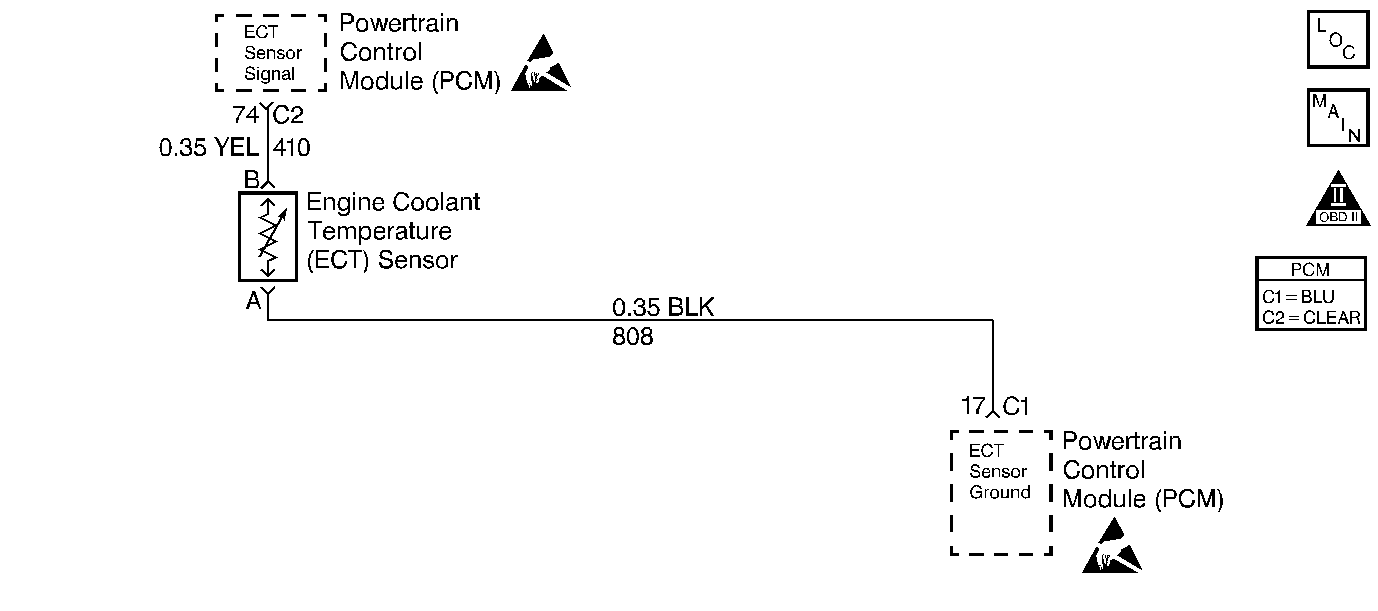
Circuit Description
The Engine Coolant Temperature sensor is a thermistor, a sensor whose resistance varies with temperature. The ECT sensor signal is on CKT 410 and sensor ground on CKT 808. As the temperature of the sensor increases, resistance decreases. A high coolant temperature will result in low signal voltage on CKT 410. DTC P0117 sets because the coolant temperature cannot be greater than 147°C (297°F) when the IAT is less than 100°C (212°F) or the vehicle has been driving long enough to cool the engine to less than 147°C (297°F).
Conditions for Setting the DTC
Test Conditions
| • | DTCs P0112 and P0113 not set. |
| • | IAT temperature of 100°C (212°F) or less. |
OR
| • | DTCs P0122 and P0123 not set. |
| • | Engine running with throttle angle between 5 and 35 degrees for at least 3.5 minutes. |
Failure Condition
The ECT sensor reading is 147°C (297°F) or more.
Action Taken When the DTC Sets
| • | PCM turns ON the SERVICE EMISSION SYSTEM message. |
| • | PCM uses the transaxle temperature sensor values in place of the engine coolant temperature sensor for the first 4.25 minutes of engine operation, and a value of 90°C (194°F) afterwards. |
| • | Transaxle shift adapts are maintained at current levels. |
| • | The PCM will illuminate the malfunction indicator lamp (MIL) when the diagnostic runs and fails. |
| • | The PCM will record operating conditions at the time the diagnostic fails. This information will be stored in the Freeze Frame and Failure Records. |
Conditions for Clearing the MIL/DTC
| • | The PCM will turn the MIL OFF after three consecutive drive trips that the diagnostic runs and does not fail. |
| • | A Last Test Failed (current) DTC will clear when the diagnostic runs and does not fail. |
| • | A History DTC will clear after forty consecutive warm-up cycles with no failures of any emission related diagnostic test. |
| • | Use a scan tool to clear DTCs. |
| • | Interrupting PCM battery voltage may or may not clear DTCs. This practice is not recommended. Refer to Clearing Diagnostic Trouble Codes in PCM Description and Operation. |
Test Description
Number(s) below refer to the step number(s) on the Diagnostic Table.
-
With the ECT sensor or wiring shorted, ECT display will read 147°C (247°F) or greater.
-
If ECT display reads -29°C (-20°F) or less with ECT sensor disconnected, wiring is okay but ECT sensor must be shorted.
Step | Action | Value(s) | Yes | No |
|---|---|---|---|---|
1 | Was the Powertrain On-Board Diagnostic (OBD) System Check performed? | -- | Go to A Powertrain On Board Diagnostic (OBD) System Check | |
Is the temperature the same or higher than the value specified? | 147°C (247°F) | Fault not present. | ||
Disconnect ECT sensor connector. Is the temperature the same or less than the value specified? | -28°C (18°F) | |||
4 |
Is resistance of each measurement greater than the value specified? | 10K ohms | ||
5 | Repair short to ground in th ECT sensor signal circuit or the ECT signal and ground circuits shorted together. Is the repair complete? | -- | Go to Powertrain Control Module Diagnosis for Verify Repair | -- |
6 |
Was terminal contact repaired? | -- | Go to Powertrain Control Module Diagnosis for Verify Repair | |
7 | Replace the ECT sensor. Refer to Engine Coolant Temperature (ECT) Sensor Replacement . Is the replacement complete? | -- | Go to Powertrain Control Module Diagnosis for Verify Repair | -- |
8 |
Was terminal contact repaired? | -- | Go to Powertrain Control Module Diagnosis for Verify Repair | |
9 | Replace the PCM. Refer to PCM Replacement/Programming . Is the replacement complete? | -- | Go to Powertrain Control Module Diagnosis for Verify Repair | -- |
